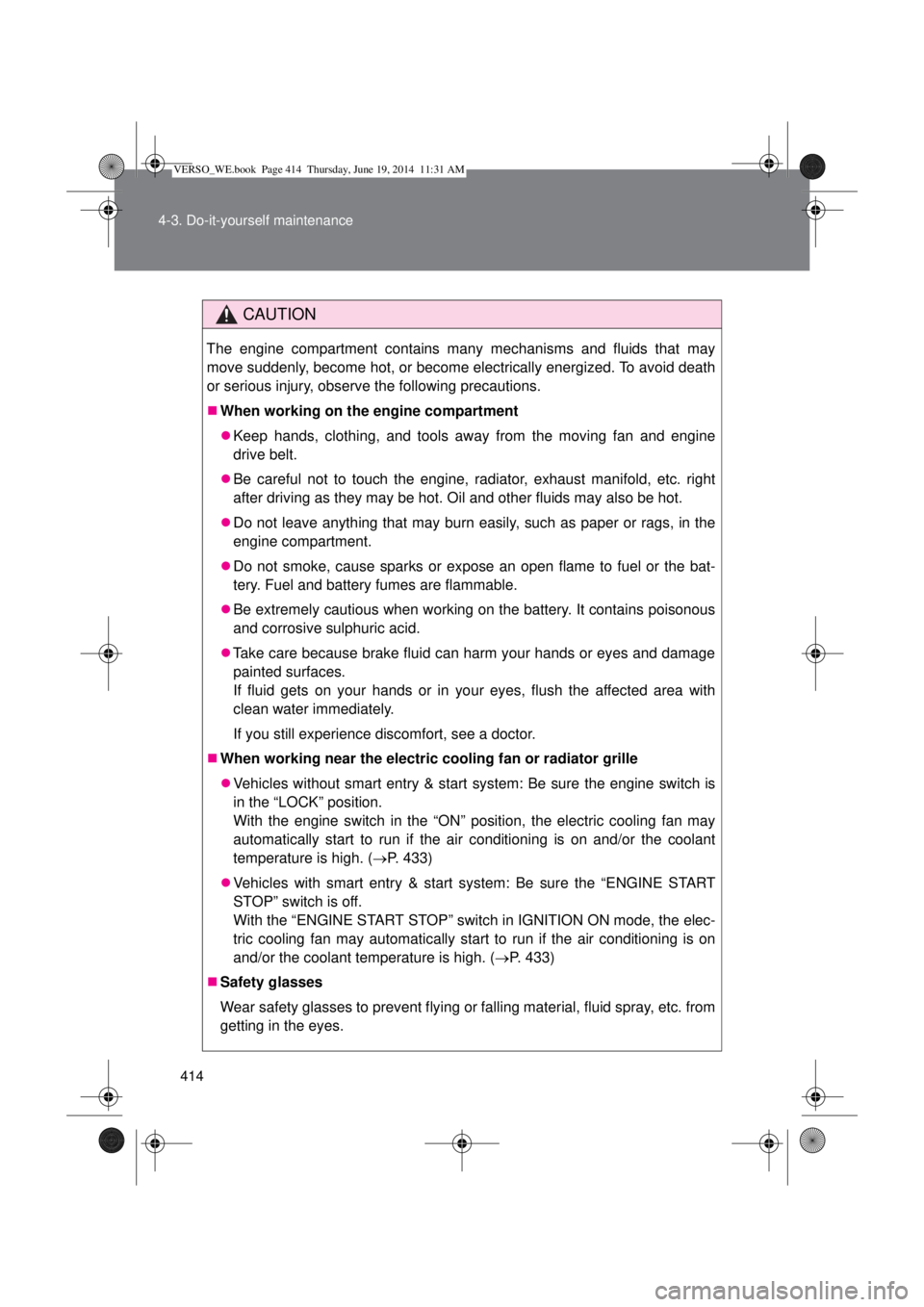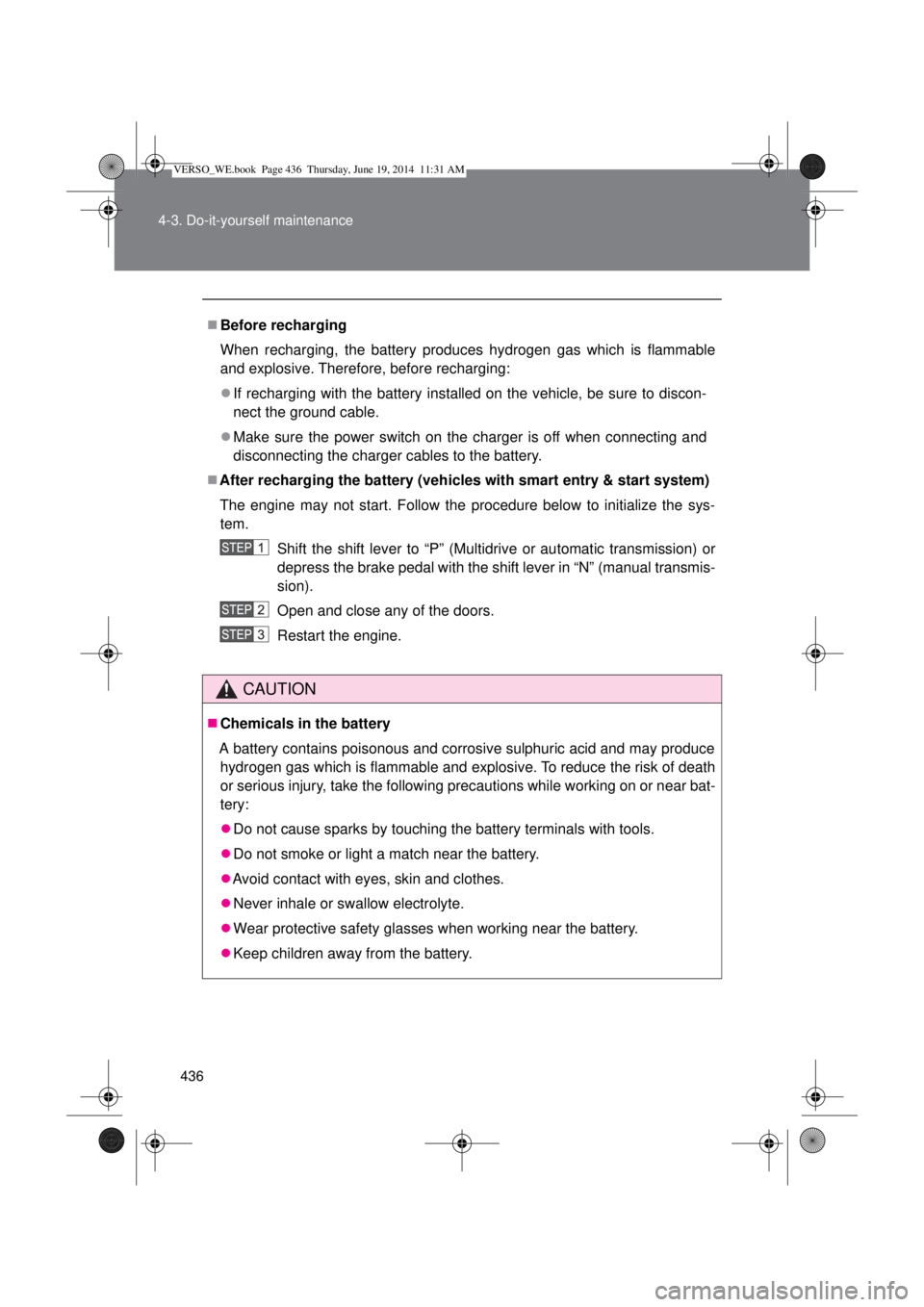Page 412 of 650

412
4-3. Do-it-yourself maintenance
Do-it-yourself ser vice precautions
If you perform maintenance yourself, be sure to follow the correct
procedures as given in these sections.
ItemsParts and tools
Battery condition (P. 434)
• Warm water
• Baking soda
• Grease
• Conventional wrench
(for terminal clamp bolts)
• Distilled water
Engine coolant level (P. 431)
1ZR-FAE, 2ZR-FAE, 1AD-FTV
and 2AD-FHV engines
• “Toyota Super Long Life Cool-
ant” or similar high quality eth-
ylene glycol based non-silicate,
non-amine, non-nitrite and
non-borate coolant with long-
life hybrid organic acid technol-
ogy. “Toyota Super Long Life
Coolant” is pre-mixed with 50%
coolant and 50% deionized
water.
• Funnel (used only for adding
coolant)
1WW-FHV engine
• “Toyota Premium Long Life
Coolant for 1WW/2WW
engines” or any of the
approved engine coolants
listed. (P. 616) “Toyota Pre-
mium Long Life Coolant for
1WW/2WW engines” is pre-
mixed with 50% coolant and
50% deionized water.
• Funnel (used only for adding
coolant)
VERSO_WE.book Page 412 Thursday, June 19, 2014 11:31 AM
Page 414 of 650

414 4-3. Do-it-yourself maintenance
CAUTION
The engine compartment contains many mechanisms and fluids that may
move suddenly, become hot, or become electrically energized. To avoid death
or serious injury, observe the following precautions.
When working on the engine compartment
Keep hands, clothing, and tools away from the moving fan and engine
drive belt.
Be careful not to touch the engine, radiator, exhaust manifold, etc. right
after driving as they may be hot. Oil and other fluids may also be hot.
Do not leave anything that may burn easily, such as paper or rags, in the
engine compartment.
Do not smoke, cause sparks or expose an open flame to fuel or the bat-
tery. Fuel and battery fumes are flammable.
Be extremely cautious when working on the battery. It contains poisonous
and corrosive sulphuric acid.
Take care because brake fluid can harm your hands or eyes and damage
painted surfaces.
If fluid gets on your hands or in your eyes, flush the affected area with
clean water immediately.
If you still experience discomfort, see a doctor.
When working near the electric cooling fan or radiator grille
Vehicles without smart entry & start system: Be sure the engine switch is
in the “LOCK” position.
With the engine switch in the “ON” position, the electric cooling fan may
automatically start to run if the air conditioning is on and/or the coolant
temperature is high. (P. 433)
Vehicles with smart entry & start system: Be sure the “ENGINE START
STOP” switch is off.
With the “ENGINE START STOP” switch in IGNITION ON mode, the elec-
tric cooling fan may automatically start to run if the air conditioning is on
and/or the coolant temperature is high. (P. 433)
Safety glasses
Wear safety glasses to prevent flying or falling material, fluid spray, etc. from
getting in the eyes.
VERSO_WE.book Page 414 Thursday, June 19, 2014 11:31 AM
Page 420 of 650
420
4-3. Do-it-yourself maintenance
Engine compar tment
Gasoline engine (1ZR-FAE and 2ZR-FAE engines)
Washer fluid tank (P. 438)
Engine coolant reservoir
(P. 431)
Engine oil level dipstick
(P. 424)
Engine oil filler cap
(P. 427)Fuse box (P. 469)
Battery (P. 434)
Electric cooling fan
Condenser (P. 433)
Radiator (P. 433)
VERSO_WE.book Page 420 Thursday, June 19, 2014 11:31 AM
Page 421 of 650
421 4-3. Do-it-yourself maintenance
4
Maintenance and care
Diesel engine (1AD-FTV and 2AD-FHV engines)
Washer fluid tank (P. 438)
Engine coolant reservoir
(P. 431)
Engine oil level dipstick
(P. 424)
Engine oil filler cap
(P. 427)Fuel filter (P. 439)
Fuse box (P. 469)
Battery (P. 434)
Condenser (P. 433)
Electric cooling fans
Intercooler (P. 433)
Radiator (P. 433)
VERSO_WE.book Page 421 Thursday, June 19, 2014 11:31 AM
Page 422 of 650
422 4-3. Do-it-yourself maintenance
Diesel engine (1WW-FHV engine)
Washer fluid tank (P. 438)
Engine coolant reservoir
(P. 431)
Engine oil filler cap
(P. 427)
Engine oil level dipstick
(P. 424)Fuel filter (P. 439)
Fuse box (P. 469)
Battery (P. 434)
Condenser (P. 433)
Electric cooling fans
Intercooler (P. 433)
Radiator (P. 433)
VERSO_WE.book Page 422 Thursday, June 19, 2014 11:31 AM
Page 434 of 650
434 4-3. Do-it-yourself maintenance
Battery
Check the battery as follows.
Caution symbols
The meanings of each caution symbol on the top of the battery are as
follows:
Battery exterior
Make sure that the battery terminals are not corroded and that
there are no loose connections, cracks, or loose clamps.
Terminals
Hold-down clamp
No smoking, no naked
flames, no sparksBattery acid
Shield eyesNote operating
instructions
Keep away from chil-
drenExplosive gas
VERSO_WE.book Page 434 Thursday, June 19, 2014 11:31 AM
Page 435 of 650
435 4-3. Do-it-yourself maintenance
4
Maintenance and care
Checking battery fluid (vehicles with gasoline engine)
Check that the level is between
the “MAX” and “MIN” lines.
“MAX” line
“MIN” line
If the fluid level is at or below the
“MIN” line, add distilled water.
Adding distilled water (vehicles with gasoline engine)
Remove the vent plug.
Add distilled water.
If the “MAX” line cannot be seen, check the fluid level by looking
directly at the cell.
Put the vent plug back on and close it securely.
Low O.K.
VERSO_WE.book Page 435 Thursday, June 19, 2014 11:31 AM
Page 436 of 650

436 4-3. Do-it-yourself maintenance
Before recharging
When recharging, the battery produces hydrogen gas which is flammable
and explosive. Therefore, before recharging:
If recharging with the battery installed on the vehicle, be sure to discon-
nect the ground cable.
Make sure the power switch on the charger is off when connecting and
disconnecting the charger cables to the battery.
After recharging the battery (vehicles with smart entry & start system)
The engine may not start. Follow the procedure below to initialize the sys-
tem.
Shift the shift lever to “P” (Multidrive or automatic transmission) or
depress the brake pedal with the shift lever in “N” (manual transmis-
sion).
Open and close any of the doors.
Restart the engine.
CAUTION
Chemicals in the battery
A battery contains poisonous and corrosive sulphuric acid and may produce
hydrogen gas which is flammable and explosive. To reduce the risk of death
or serious injury, take the following precautions while working on or near bat-
tery:
Do not cause sparks by touching the battery terminals with tools.
Do not smoke or light a match near the battery.
Avoid contact with eyes, skin and clothes.
Never inhale or swallow electrolyte.
Wear protective safety glasses when working near the battery.
Keep children away from the battery.
VERSO_WE.book Page 436 Thursday, June 19, 2014 11:31 AM